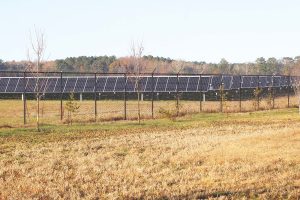How, or if, Worcester County could do more to regulate solar projects on agricultural land was a topic of discussion at a recent commissioners meeting.

The Gateway Solar Farm on Old Ocean City Road in Berlin is pictured.
File photo
By Bethany Hooper, Associate Editor
How, or if, Worcester County could do more to regulate solar projects on agricultural land was a topic of discussion at a recent commissioners meeting.
On July 16, the Worcester County Commissioners invited Maryland Association of Counties (MACo) Executive Director Michael Sanderson and Intergovernmental Relations Director Dominic Butchko to speak on utility scale solar systems and the pressures they place on the county’s agricultural land. Sanderson said despite his association’s efforts to fight for Maryland’s counties in the preservation of agricultural activities, state interest in reaching renewable energy targets continues to be a challenge.
“It’s a major issue,” he said. “It has been for a number of years. It’s still alive and the temperature continues to escalate.”
In recent years, commissioners have expressed concerns regarding solar projects being developed on prime agricultural lands. Currently, county code permits utility scale solar systems in several zoning districts, so long as the lot exceeds 50 acres, according to a memo sent to the county commissioners. However, the Maryland Public Service Commission has the ultimate authority on projects more than two megawatts.
So anything below that, you’re in control,” Butchko told commissioners last week. “Anything above that, you have to get a Certificate of Public Necessity and Convenience from the Public Service Commission.”
Sanderson said rural counties like Worcester are starting to feel the pressures of solar development, as their low-lying farms – relatively close to both the roadway and the power grid – are appealing to companies. Rather than go through local approvals, they are going to the state, which has set its own renewable energy targets.
“It didn’t take long for us to realize this was not just a Kent County problem or not just a Caroline County problem, it was definitely the whole of the Eastern Shore and really more,” he said. “Almost every place that’s heavy in agriculture is starting to feel this pressure.”
Officials noted that the state has set a goal that 14.5% of all energy generated by 2028 come from solar. And within the Maryland General Assembly, several bills have been introduced to limit a county’s authority over solar projects.
“We are in jeopardy of seeing what little guidance we have at the local government be eroded even further,” Sanderson said. “So the trend line on this issue is worrisome, and our forecast in the General Assembly is we think we are on the losing side of this debate. If there are changes in the law, they look like they’re heading in the direction of more and faster clean energy sources and development, as opposed to more restrictions and limitations and slowdowns.”
Butchko noted that the Maryland Public Service Commission does consider local input when approving a Certificate of Public Convenience and Necessity, or CPCN. However, he said local governments were more or less stripped of their autonomy.
“You do have some input through state processes to say we don’t want it here, we have this policy, we want this setback,” he explained. “The state does consider that in their approval, but I think there were about 100 CPCNs, only two of them, give or take, have gotten denied.”
Butchko told commissioners that MACo continued to work toward compromise. However, he said solar legislation was becoming “more aggressive.”
“I don’t want to give you too much hope because there’s a lot of pressure,” he said. “The state is under a lot of pressure from the environmental community, the state’s under a lot of pressure from the energy industry. We don’t have the best card of hands here.”
Commissioner Chip Bertino questioned if the November election could impact what happens to solar in Maryland. Butchko said it likely wouldn’t.
“There might be some changes on the periphery, especially like federal subsidies,” he replied. “But Maryland has made both the General Assembly and this current administration a very big commitment to hitting 100% renewable energy. Even if there is a change at the federal level, I doubt that that would change anything at the state level.”
Worcester County Chief Administrative Officer Weston Young asked MACo representatives if the state’s solar policies were contradictory to its conservation and housing efforts. Butchko argued the state was giving counties conflicting objectives.
“I can tell you that your association is making the state policymakers very aware of the conflict that they’re creating,” he said.
Last week’s discussion comes nearly two months after Worcester County agreed to rescind its denial letter to the Public Service Commission for a solar project in Snow Hill, officially settling an administrative appeal that Chaberton Snow Solar LLC filed in circuit court last year. The commissioners voted against the project with little discussion other than concerns about equipment disposal decades down the line, prompting the property owner, Charles Waite, to openly question the elected officials.
“Worcester County’s director of development and review, Jennifer Keener, explained the Maryland Public Service Commission will decide the future of the solar project. However, upon review of the commissioners’ vote and a clear precedent that a 10-15 acre solar application is already in existence just yards over the property line from the future site, I believe the voters and community should expect a motion to reconsider this project from one of the commissioners from the prevailing side,” Waite said.
